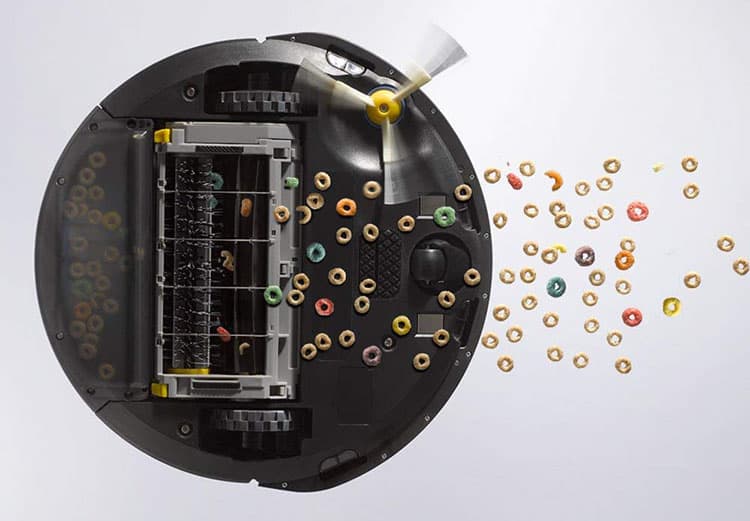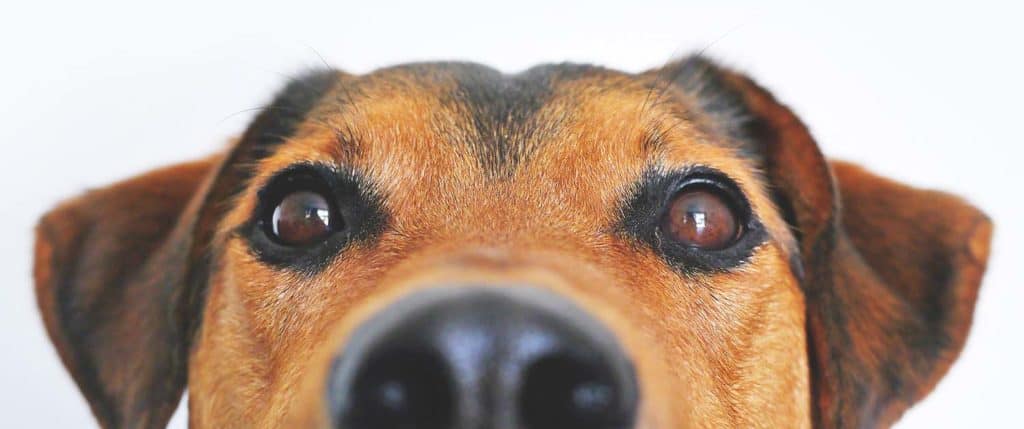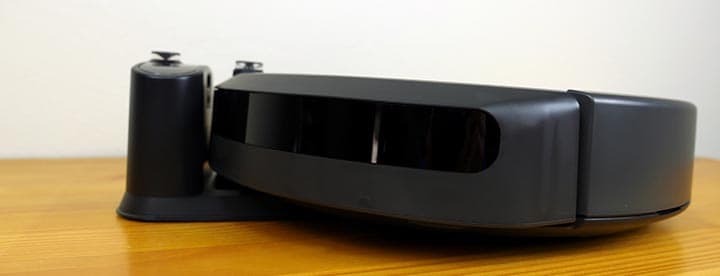Rosie, Predy, Wallie—at first glance, you might think these are fun pet names, but what if I told you these were actually the names of family household robot vacuums?
It may sound far-fetched, but it’s actually true. Each of these robots is a separate vacuums that runs and maintains three separate homes, all while co-existing with family dogs.

Today’s vacuum cleaners, unlike those of the past, have really come a long way technology-wise.
Cord-free, self-directing—these robot vacuums may sometimes even seem to have a mind of their own (and in a sense, they really do).
But as more homes have welcomed the addition of a robot vacuum, more pets are left trying to figure out life with their new robot companion.
In the past, pets and vacuums have been life-long enemies, but that arch rivalry may be fading with the new generation of vacuums on the market today.
FAQ: Looking for the best robot vacuum for pets? Check out the Roomba 690 robot vacuum review.
Vacuum Cleaners vs. Dogs
In the past, the majority of household vacuums were uprights, stick, or canisters.
They were relatively loud and had long hoses and cords, and when pushed by their “master,” they sometimes had a way of “chasing” pets (or so it could seem to many dogs).
Cords could trip up animals and many dogs and cats felt cornered by the vacuum when caught off guard. Most robot vacuums are a far cry from this upright monster.

Robot vacuums are cordless, are generally notably quieter, and typically have a more leisured approach to cleaning. Instead of charging directly forward and back, many robot vacuums tend to meander around a room or space.
They methodically clean and calculate, but doing in a much less abrupt manner than other types of vacuums.
HAIR: Pet hair everywhere? Check out the Bissell Pet Hair Eraser review
So what does this mean for pets?
In many cases, it means that vacuum cleaners can be taken off the Bark List.
Poodle vs. Roomba
Tibbers is a full-blooded miniature poodle with boundless energy and a love for chase.
When we first brought Tibbers home, our Roomba 870, Predy (short for Predator), was already an established part of the family.

As a newcomer, Tibbers was a little hesitant around Predy, but she quickly learned that the vacuum was not the enemy.
Likewise, the vacuum would not play fetch, chase, or interact in any way, so it wasn’t really a friend either. For the most part, my poodle simply ignores the robot.
Occasionally, it will get a little too close for comfort during its cleaning cycle and she’ll move to the other side of the room, but for the most part the two simply ignore each other.
Beagle vs. Roomba
This is my sister’s dog, Thor.
Thor is a beagle / corgi mix with a strong love for sleeping and a strong distaste for things that disrupt that.

When we brought our Roomba 870 home, the dog was skeptical at first. But once he realized that it wasn’t directly targeting him, he basically started ignoring it.
Like two ships passing in the night, Thor can enjoy an afternoon nap, while Rosie (Roomba 870) cleans away.
In the cases where he is napping in the same space as the robot vacuum, he will simply get up and move to a different room.
The one time that he didn’t move for the vacuum, it bumped right into his sleeping belly. Thor never made that mistake again.
Robot Vacuum Noise Levels
While there are many factors and differences between robot vacuums and more traditional vacuum types, perhaps one of the biggest factors may simply be the relative noise levels.
Most upright, stick, and other traditional vacuum cleaners tend to be notably louder than robot vacuum cleaners.
In our vacuum cleaner performance testing we use a sound meter to measure the noise level (in decibels).
Below are a few common robot vacuums and their respective noise levels at 3′ away
- Roomba 690 – 68 decibels
- Roomba 650 – 61 decibels
- Eufy Robotvac 11 – 56 decibels
- Ecovacs Deebot N79 – 56 decibels
We compared this to several more traditional vacuums and their respective noise levels at 3′ away:
- Shark Rocket (stick) – 80 decibels
- Dyson Small Ball Animal Compact (upright) – 80 decibels
- Bissell Pet Hair Eraser (handheld) – 78 decibels
- Electrolux Ergorapido (stick) – 74 decibels
Lastly, here’s a quick chart we put together to show you common noises and their respective decibel levels.

At 3′ away, the Roomba 650 emits 61 dB of sound.
I am certainly not a vet or pet pscyhologist, but I have had many dogs over the years.
I have a strong feeling the noise level may be as big of a factor as any when it comes to why many dogs don’t tend to mind robot vacuums as much as more traditional larger vacuums.
Pack Order Dynamics
Dogs that have been an established part of the family for a prolonged period of time may struggle with a phenomenon called “pack order.”
The idea behind “pack order” is that everyone in the family has a rank.
As head of the household, humans are at the top (or at least they should be), with pets falling somewhere below, depending on how you and your family have interacted with the dog.
It can be difficult for dogs to understand where robot vacuums are in the pack hierarchy.
From the dog’s perspective, these vacuums are autonomous beings that go where they want, when they want, and they don’t ever seem to ever submit to the pack leader (which should be you!).

As a result, I’ve heard a number of stories where owners of robot vacuums have had to “discipline” the robot vacuum in front of the dog. “Disciplining” the robot vacuum helps the dog understand that the robot vacuum is part of the pack.
Most importantly, it communicates that the vacuum is under your control and you are a leader of the robot. Once the dog understands this concept, he or she may be able to accept the robot more readily.
Robot Vacuums vs. Dogs & Cats
Once your pets get past the initial fear of the robot vacuum, they may grow to become great companions or at least sparring partners.
A quick YouTube search for “dog vs. Roomba” or “cat riding Roomba” can yield countless videos-and hours of laughs.
In the case of the Modern Castle team’s pets, and in the case of many others we’ve talked to or read about, most dogs and cats simply ignore the robot.
However, it really will depend on the personality of your pet. Some dogs are naturally inclined to be more stressed and concerned by it, others may want to play or fight with it, and still others may pay it no attention at all.
Over time, your pet should relax more, but as a word of caution, do not let your pet get too relaxed around the vacuum.
So relaxed, per se, that a #2 type of accident happens in the house. There’s a word for these types of accidents with robot vacuums: poo-pocalypse.

The following occurred to my sister and Modern Castle Staffer, Kayla, a few years ago:
“The Great Poo-Pocalypse of 2014 happened when our dog unknowingly hid a special treat in the formal dining room while we were sleeping…
In natural Roomba 870 fashion, Rosie was up and cleaning at the crack of dawn, per our scheduled cleaning cycle.
But this cycle was different. Instead of cleaning, our robot vacuum ran into the… shall we say “debris” and proceeded to spread it all around the house.
It was in every single room, caked in the brushes, stuck in the roller, and one thousand times more of a mess than it would have been without the “help” of our robot vacuum.
Recommendations for the next iteration of robot vacuums to sweep the market = Poo sensors.
Still not sure if a robot vacuum is a good choice for your home? Check out or Robot vacuum reviews or drop us an email. We’re always available to help.
